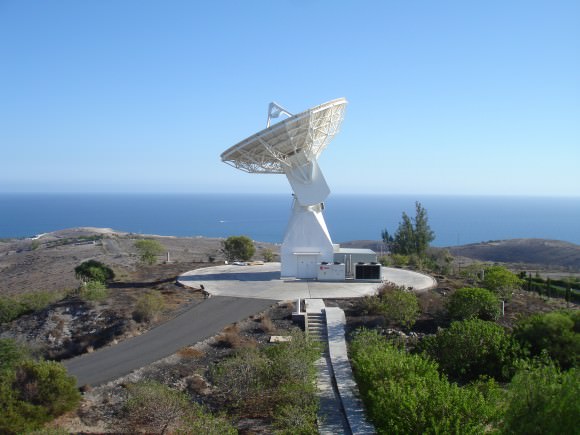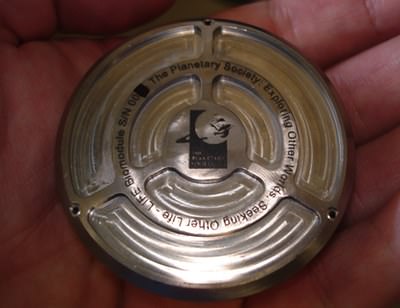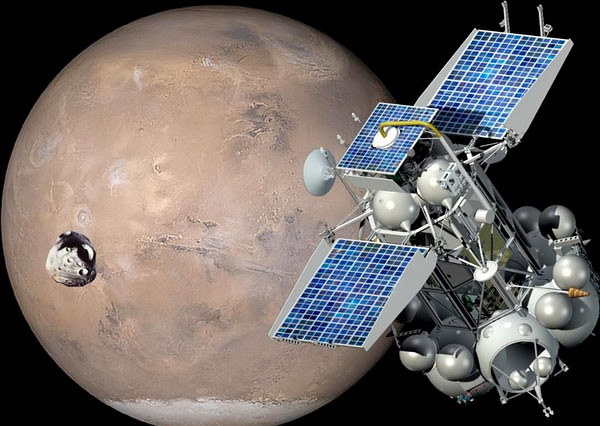[/caption]
Editor’s note: Dr. David Warmflash, principal science lead for the US team from the LIFE experiment on board the Phobos-Grunt spacecraft, provides an update on the mission for Universe Today.
Russia’s Phobos-Grunt spacecraft is in no better position than it was a month ago, when it reached low Earth orbit on November 9 yet failed to ignite the upper stage engine that was to propel it to Phobos, the larger of Mars’ two small moons. Indeed, with an orbit measuring 204.823 kilometers at perigee (the low point) and 294.567 kilometers at apogee as of today, the spacecraft is well on its well to a fiery reentry through Earth’s atmosphere in early January if it cannot be rescued in the intervening time. But the Russian space agency, Roscosmos, is not ready to give up on the probe yet, and have asked ESA to resume trying to contact Phobos-Grunt.
Despite success in contacting Grunt and getting it to send telemetry two weeks ago using a modified antenna in Perth Australia, subsequent attempts to command the spacecraft to boost her orbit failed.
Then last week, after modifying another antenna, this one in Maspalomas on the Canary Islands, the European Space Agency (ESA) announced that efforts to track and communicate with the spacecraft would end. As a result, any remaining hope that the craft might at least be boosted to a more stable orbit to allow for diagnoses and eventual repair faded away.

But, in response to requests from the Russian Space Agency (Roscosmos), ESA now has decided to renew tracking and communications efforts from the Maspalomas station. Located off of the northwest coast of Africa, Maspalomas is well-situated with respect to Phobos-Grunt’s course around Earth. Since fewer communication attempts have been made from Maspalomas as compared with Perth, ESA and Roscosmos may be thinking that not all potential tricks to get the geometry right have been exhausted. Thus, new attempts to hail the unpiloted science probe began on Monday and will continue through Friday, December 9th. Presumably, ESA would continue to support the mission beyond Friday, if anything happens suggesting that Phobos-Grunt has received the instructions and is capable of responding, even in part.
Designed to land on the surface of Phobos, the Grunt spacecraft carries about 50 kilograms of scientific equipment built to make celestial and geophysical measurements, and to conduct mineralogical and chemical analysis of the regolith (crushed rock and dust) of the tiny moon. The chemical analysis that is to be conducted includes a search for organic matter, the building material for life. Studies to be conducted on the Phobosian surface potentially could elucidate the origins of Phobos and the other Martian moon, Deimos. Additionally, the presence of organic matter on Phobos would suggest that the surface of Mars itself contains organics. Despite findings by NASA’s Viking landing crafts in the 1970s suggesting that the surface of Mars lacks organic material, studies by more recent probes suggest that compounds known as perchlorates –detected by Viking but dismissed as contaminants from Earth– may have been native to Mars. This issue will be investigated further when NASA’s Curiosity rover arrives on the Red Planet several months from now.

Grunt also carries Yinhou-1, a Chinese probe that is to orbit Mars for 2 years. After releasing Yinhou-1 into Mars orbit and landing on Phobos, Grunt is designed to launch a return capsule, carrying a 200 gram sample of regolith back to Earth. Also traveling within the return capsule is the Planetary Society’s Living Interplanetary Flight Experiment (LIFE), designed to investigate how readily living forms could spread between neighboring planets.
Although prospects for this ambitious mission still look bleak, Alexander Zakharov of Russia’s Space Research Institute, who was instrumental in getting the LIFE experiment onto the Grunt mission, has suggested that a new Grunt mission might be launched, presumably on time for the next launch window to Mars, which opens in approximately 26 months.
Meanwhile, today, NASA’s space debris chief said that Phobos-Grunt would pose no threat to Earth when it reenters the atmosphere.
Although the window for a trip to Mars is about to close, should control over Phobos-Grunt be restored, it might be kept in a higher orbit for two years, or sent to an alternate destination, such as Earth’s own Moon, or an asteroid.


Great article. Interesting!!!
Quoting article:
…perchlorates…detected by Viking but dismissed as contaminants from Earth– may have been native to Mars.
//end quote//
I find it curious that the Viking 1/2 landers and Phoenix polar lander both detected perchlorates and this seems to have been dismissed on questionable evidence, ie.:
All three landers did NOT contain perchlorates (however the main rockets for launch did) as follows –
In the case of Viking 1’s propulsion system quoting http://en.wikipedia.org/wiki/Viking_program
Terminal descent and landing utilized three (one affixed on each long side of the base, separated by 120 degrees) monopropellant hydrazine engines.
and
http://en.wikipedia.org/wiki/Phoenix_lander
twelve 68.0 lbf (302 N) Aerojet monopropellant hydrazine thrusters to land the Phoenix
However I believe it is quite plausible the perchlorates detected in the landing zone could have orginated from the launch propellants of the Viking and Phoenix landers.
// Quoting http://en.wikipedia.org/wiki/Viking_program
Viking 1 was launched on August 20, 1975, and the second craft, Viking 2, was launched on September 9, 1975, both riding atop Titan III-E rockets with Centaur upper stages.
and
http://en.wikipedia.org/wiki/Titan_II_%28rocket%29
The Titan III was a modified Titan II with optional solid rocket boosters.
and
http://en.wikipedia.org/wiki/Phoenix_lander
Phoenix was launched on August 4, 2007, at 5:26:34 a.m. EDT (09:26:34 UTC) on a Delta 7925 launch vehicle
and
http://en.wikipedia.org/wiki/Delta_II
Solid rocket booster motors: Used to increase thrust during the initial two minutes of flight. The medium-capacity Delta II has nine motors total (six fire on the ground, three in flight); the other models use only three or four.
So as we can see here both Viking landers and the Phoenix landers used primary launch systems involving solid fuels (ammonium and aluminium perchlorate containing solid fuels).
So I believe it may bepremature to conclude that surface contamination by the landers being in proximity to the launch systems based on the following line of evidence:
http://en.wikipedia.org/wiki/Viking_program
The validity of the positive ‘Labeled Release’ (LR) results hinged entirely on the absence of an oxidative agent in the Martian soil, but one was later discovered by the Phoenix lander in the form of perchlorate salts.[10][11] The question of microbial life on Mars remains unresolved.
and
http://en.wikipedia.org/wiki/Perchlorate
The possibility that the perchlorate was a contaminant brought from Earth has been eliminated by several lines of evidence. The Phoenix retro-rockets used ultra pure hydrazine and launch propellants consisted of ammonium perchlorate. Sensors on board Phoenix found no traces of ammonium, and thus the perchlorate in the quantities present in all three soil samples is indigenous to the martian soil.
Seems to me it would be wise to send lander some day that doesn’t involve perchlorates in any of the launch, cruise, orbit or de-orbit EDL stages, to convince this sceptic that the perchlorates were an indegenous species to Mars soil.
To my mind, it can be quite possible for the perchlorate contaminants to have been ‘pushed out’ by a jetisonned component – such as: aeroshell is jettisoned and parachute deployed — I wonder what kind of pyrotechnic fastener / explosive bolt / pyro’s were used ????
And GO PHOBOS TEAM and the truly international collaboration to re-establish communications! Lets get this bird on her way to Mars 😉
arent the probes inside a capsual at launch?
As your quotes mentioned, the detected perchlorates were native.
They explain what happened in both Viking and Phoenix chemical experiments when they tried to analyze for organics with heat or provide energetic organics (nutrients), those were oxidized.
Curiosity will look for organics and perchlorates, so the confirmation will come soon.
Hi Torbjörn,
I didn’t get time to respond to this properly so here goes.
When the rockets are in the Side Integration Facility (prior to VIF) there is always small chance of contamination of detector equipment. Small chance I admit.
However, the Pryotechnics or Exp.bolts used to deploy chutes and in particular EDL seperation event, can generate ammonium-chloride compounds (perchlorates). Personally I would like to see the formula for the pyro’s to know but I understand it aint gonna happen.
Best regards,
Wesley Jackson
Subject: [universetoday] Re: Not Giving Up Yet: ESA Resumes Effort to Communicate with Phobos-Grunt
Admiring your optimism, but sounds like they tried and failed, gave up – but are now going to give it one more go with the same gear that has already not worked. Sorry for the waterbears.
Meanwhile, an American craft is currently on the edge of the solar system…
Yep, we’re the best!
Although the Russians hold the record for the furthest distance travelled on the surface of another world, which stands at 37km driven by Lunokhod 2 over 4 months in 1973. You win some, you lose some.
I can’t wait to see this thing enter the atmosphere. With all that fuel, it should make quite a bang and light show when it burns up.
Why Not Send The U.S.A. Retired Space Shuttle To Help Them Put It Further Out Into A Better Orbit?
Would you care to venture a guess as to the costs involved in putting Humpty Dumpty back together again?
It would be cheaper to build and launch several new PhobosGrunts.